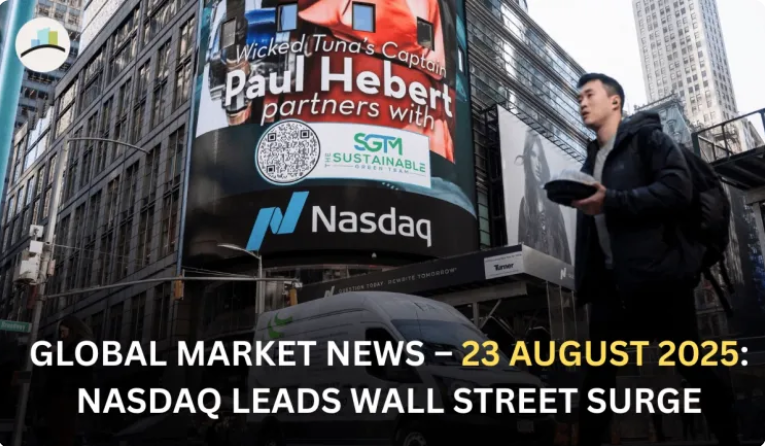
Nasdaq powered Wall Street’s rally on August 23, 2025, as Powell’s Jackson Hole remarks boosted hopes of a September rate cut, sending tech stocks to fresh highs.
The U.S. stock market roared to new highs Friday as investors latched onto Federal Reserve Chair Jerome Powell’s closing remarks at Jackson Hole. The Dow Jones Industrial Average jumped more than 800 points to a record level, while the S&P 500 and Nasdaq also surged. Traders now see an increased likelihood of a September interest rate cut, sparking optimism across equities.
This rally was not just about Powell’s words — it reflected months of investor anxiety finally meeting a turning point. With inflation cooling, growth moderating, and political pressure mounting, the Fed is now navigating one of the most delicate transitions in years.
Why the Rally Happened
Powell didn’t announce an immediate cut, but his tone suggested the Fed may finally be comfortable easing policy. His remarks emphasized “sustainable disinflation” and a readiness to adjust rates if the economy continues to cool. Markets had been waiting for this signal, especially after months of mixed data.
Another driver: Treasury yields slid as bond traders priced in looser policy. Lower borrowing costs boost corporate valuations, helping tech and growth stocks soar. It’s no coincidence that the Nasdaq rallied hardest — rate-sensitive sectors are always the first to react.
The Bigger Picture: What It Means for the Economy
A September cut would mark the Fed’s pivot from fighting inflation to supporting growth. For households, this could mean cheaper mortgages and lower credit costs. For businesses, easier financing could accelerate hiring and investment. But there’s a catch: if the Fed moves too soon, it risks reigniting inflation, particularly in housing and energy.
Historically, post-Jackson Hole pivots have carried weight. In 2019, Powell’s hints preceded a cycle of rate cuts to shield the economy from trade war fallout. Today, the stakes are even higher, with the U.S. managing inflation, election-year politics, and global uncertainty all at once.
Hidden Risks Wall Street May Be Ignoring
While markets cheered, not all risks have disappeared. Inflation remains above the Fed’s 2% target, and energy prices could rise if geopolitical tensions flare. The U.S. consumer, while resilient, is showing cracks in spending behavior as savings dwindle. Corporate earnings forecasts also remain cautious, signaling that Wall Street may be running ahead of fundamentals.
Another overlooked angle: global central banks. If the European Central Bank or Bank of Japan delay easing, dollar strength could return, complicating U.S. exports and pressuring multinationals.
What Happens Next
Investors will watch closely for the Fed’s September meeting, where updated economic projections could provide clarity on the pace of cuts. A 25-basis-point trim is now widely expected, but markets could be disappointed if Powell holds back again.
For now, the rally underscores renewed investor confidence, but also sets the stage for heightened volatility. In the coming weeks, expect sharp moves tied to labor market data, corporate earnings, and inflation updates.

